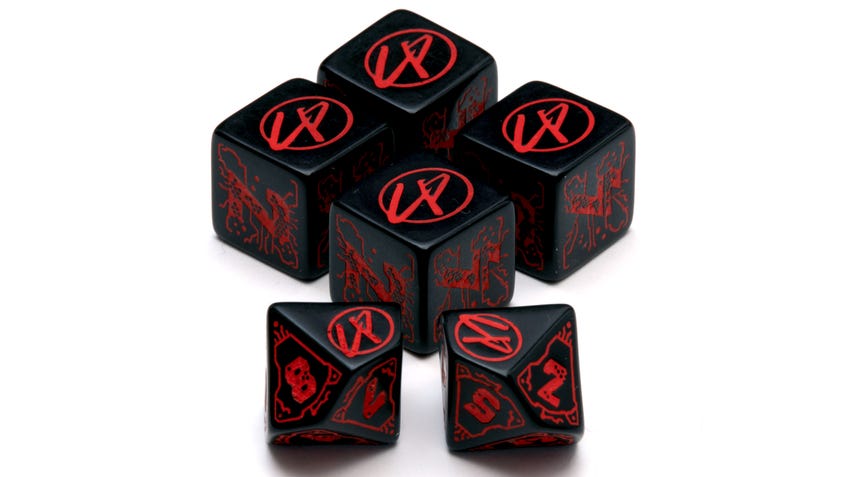How to play the Cyberpunk Red tabletop RPG: A beginner’s guide
When to roll, what to roll and how to get started with the Cyberpunk Red RPG.
Right now is a pretty great time to start exploring the world of the Cyberpunk tabletop RPG. We have a video game adaptation, Cyberpunk 2077, dropping in a couple of months and a brand new edition of the tabletop RPG, Cyberpunk Red, coming soon after, with the Cyberpunk Red Jumpstart Kit - a starter set with beginner-friendly rules and pre-made characters - already on the shelves.
In this beginner’s guide to the Cyberpunk Red RPG we’re going to be going over the very basic of the latest ruleset. While a good deal easier to jump into than previous edition Cyberpunk 2020 (which had some pretty good predictions about how this year might look when it was released 30 years ago), it’s a reasonably complex roleplaying game - especially when compared to learning how to play Dungeons & Dragons 5E and other similar RPGs. As such, there is a heck of a lot more detail wedged into the rulebooks, but if you’re looking to dip your toe into learning how to play Cyberpunk Red this should be a good place to start.
When we say “dip your toe” we really mean that, because we’re working from the fundamentals up. If you’ve played a tabletop roleplaying game such as Dungeons & Dragons before you can probably skip right past this next section but if you haven’t, it’s important to get a grip on what to expect from the Cyberpunk Red RPG.
How to play Cyberpunk Red RPG
At some fundamental level, all tabletop RPGs are the smashed-together cousins of board games and improv storytelling. Most of the group - which is usually between three and six people - take up the roles of characters in the game world, in this case the dystopian techno-future of Cyberpunk. They act as the main characters of our story and get up to all kinds of weird hijinks, such as breaking into secure mainframes as code-cracking Netrunners and getting into street fights as a brawling Fixer.
One of the players doesn’t take the role of just one character, but rather assumes the mantle of game master (GM). This leaves them in control of... well, everything in the world that isn’t the handful of renegades controlled by the rest of the group. They give voice to the barista at the megacorp coffee shop, decide how many thugs show up when the team trespasses on their turf and generally manage the imaginary reality.
Between them, the group works together to tell cool stories, grow their characters and have some goddamn fun. When it goes well, the experience is something that’s hard to beat - as you'll know if you've watched the Dicebreaker team's Cyberpunk Red playthrough with co-designer Cody Pondsmith.
What separates an RPG like Cyberpunk Red from table-bound theatre, however, is its use of rules. What the heroes and villains can do is regulated by a stack of systems and the roll of the dice, which come together to give the world a sense of structure and fairness.
In practice many groups soon find that the rules are actually more of a guideline, dropping some ideas and altering others, but it’s generally good advice to at least start out following them. That way, when you start tinkering you’ll know what you’re looking for.

How do stats and skills work in the Cyberpunk Red RPG?
Before we touch any dice, we need to understand a little bit about who’re playing as. Fortunately, most of this information can be found in just one place: the character sheet. This is essentially a big old list of all the vital details and statistics for your particular character, ranging from their name and class to what kind of cyberware they have jammed into their skull.
There’s a fair bit to take in here, but for now the most important numbers on there are your characters’ stats and their skills.
Stats represent things that are innate to the character, like their natural reflexes or ability to stay cool under pressure. Skills, on the other hand, are talents that have come about through training and hard work (most of which happens happily off-screen). These two combine to determine how good you are at pulling off the desperate, dangerous and thoroughly badass stunts that make up the day-to-day life of a cyberpunk.
For example, a character’s ability to fire a teched-out machine pistol as they leap over the hood of a parked car relies on both their reflex stat and their marksmanship skill. If they had, say, a score of eight in reflex and a four in marksmanship, they’d end up with a total of +12 when it comes to shooting. Which, as it happens, isn’t half bad.
Now, some of you may be asking why we need that ‘+’ stuck onto the number. Well, it’s there because we’re finally going to get rolling.
When to roll dice in Cyberpunk Red
Real life - and, by extension, the made-up future reality of Cyberpunk Red - is a wonderfully random thing. Bad luck and poor timing can cause even the greatest masters to sometimes fail, while a chance ricochet or unexpected bounce can sometimes lead a rank amatuer to a shocking victory.
This is why so many RPGs rely on the roll of a die. These little plastic shapes act as the arbiter of fate for our fantasy worlds, and their random jigglings can completely reshape the stories we tell.
In the case of Cyberpunk Red, we entrust our destinies to a ten-sided die - commonly known as a d10. This is what we roll whenever our characters try to take on something risky, and is what stops the game from becoming a simple act of seeing whose numbers are bigger whenever you get into a fight.
If you want to sneak past some corporate cops patrolling the lobby, for example, you’d add up your dexterity stat and stealth skill, and then roll a d10. The combined total would give you some idea of how well you did, though whether you actually succeed would depend on how well the cops did on their own roll, which relies on their intelligence and perception - plus the luck of the GM, who rolls on behalf of any non-player characters (NPCs).
Their final result is higher? Bad luck, they spot you and draw their guns. If you came out on top, however, you sneak past them and into the elevator shaft with no problems whatsoever.

What is a difficulty value (DV) in Cyberpunk Red?
Of course, not everything we try and do has an obvious rival to work against. Jumping out of a plate-glass window and trying to land in the getaway car is cyberpunk as all hell, but trying to roll off against gravity itself seems a little silly.
In these cases, our goal isn’t to beat some opponent’s score, but rather some number that roughly corresponds to how hard the task is. This is a fairly imprecise science, but fortunately the rules lay out a few guidelines for GMs to work off.
Something tough but fairly straightforward, like quickly weaving a groundcar through traffic, might have a difficulty value (DV) of 14, while something truly badass - like that leap-though-the-window trick - might require you to get a total of 22.
Meet the DV and you land where you want to be, cool as a chrome cucumber. Fall short and you drop onto the concrete like a dweeb. A dweeb with broken ankles.

How do you hack in the Cyberpunk Red RPG?
One of the coolest and most iconic parts of any cyberpunk game is the ability to interact directly with computer networks. Entire missions can revolve around getting a Netrunner - think a computer hacker but with more chrome and holes in their skull - into a location where they can thieve valuable information from a server.
However, the rules around Netrunning are pretty detailed, so if you feel like cracking your knuckles and announcing “I’m in” to the rest of the table you’re going to have to do a little bit more prep-work before playing.
Don’t worry too much, though. Netrunning is built around the same rules as the rest of the game, so you’ll still be rolling d10s and comparing them to DVs. The biggest difference is that you have a pretty hefty stash of extra actions you can take while jacked into a network. The ‘Backdoor’ command, for example, allows you to bypass passwords, while ‘Zap’ would let you fend off security programmes or even roast the brain of a hostile Netrunner.

Networks are divided up into different levels, each with their own security and their own goodies to be found, whether that’s the payroll database or the system controlling the security cameras. In fact, exploring the network is a lot like delving a dungeon or - in keeping with Cyberpunk Red's setting of a sci-fi dystopia - taking elevators to different floors of a corporate tower.
The deeper you go the more you can find, but the more you risk an encounter with Black ICE: deadly attack programmes that can kick you out of a network and potentially damage you in real life. Combat with these digital monsters is handled much as it is in meat-space - the game’s ever-so-lovely term for reality - though there are fewer guns and more mind-bullets.
There’s a bit more to it than that, honestly, but if you keep a reference sheet of your options handy things should start falling into place pretty quickly.
In fact, that kind of applies to the entire game. So long as you keep the fundamentals in mind you’re probably ready to pick up the Cyberpunk Red Jumpstart Kit and get rolling.
See you in the streets, Cyberpunk.


